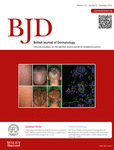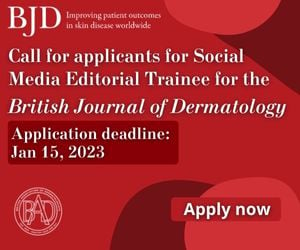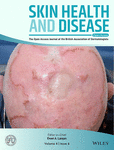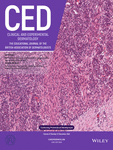Journal list menu
Export Citations
Download PDFs
Editor's Choice
EDITORIALS
Antibiotics and acne: an emerging iceberg of antibiotic resistance?
- Pages: 1127-1128
- First Published: 20 December 2016
Can you have your cake and eat it too? The sunlight D-lema
- Pages: 1129-1131
- First Published: 20 December 2016
Dermoscopy in Europe: coming of age
- Pages: 1132-1133
- First Published: 20 December 2016
COMMENTARIES
Antihistamine updosing in chronic urticaria – is there enough evidence?
- Pages: 1134-1135
- First Published: 20 December 2016
Linked Article: Guillén-Aguinaga et al. Br J Dermatol 2016; 175:1153–1165.
Epidermal growth factor receptor inhibitor-associated rash prevented by oral tetracyclines
- Pages: 1135-1136
- First Published: 20 December 2016
Linked Article: Petrelli et al. Br J Dermatol 2016; 175:1166–1174.
Skin cancer in the end-stage renal disease population: unique risk factors for patients on dialysis
- Pages: 1136-1137
- First Published: 20 December 2016
Linked Article: Wang et al. Br J Dermatol 2016; 175:1175–1182.
Statin exposure and the risk for herpes zoster: implications for public health
- Pages: 1137-1138
- First Published: 20 December 2016
Linked Article: Matthews et al. Br J Dermatol 2016; 175:1183–94.
Expanding genetics and phenotypic spectrum of epidermodysplasia verruciformis
- Pages: 1138-1139
- First Published: 20 December 2016
Linked Article: Li et al. Br J Dermatol 2016; 175:1204–1209.
JNK–ERK signalling in melanoma: rewired or entangled?
- Pages: 1139-1140
- First Published: 20 December 2016
Linked Article: Pathria et al. Br J Dermatol 2016; 175:1221–1231.
Fatal attractions? Correlations of CXCL12–CXCR4–CXCR7 expression with disease progression in melanoma and Kaposi sarcoma
- Pages: 1140-1141
- First Published: 20 December 2016
Linked Article: McConnell et al. Br J Dermatol 2016; 175:1210–1220.
Linked Article: Desnoyer et al. Br J Dermatol 2016; 175: 1251–1262.
Psoriasin (S100A7): a novel mediator of angiogenesis
- Pages: 1141-1142
- First Published: 20 December 2016
Linked Article: Vegfors et al. Br J Dermatol 2016; 175:1263–1273.
Is DRESS syndrome a single entity or within a spectrum of adverse reactions to drug?
- Pages: 1142-1144
- First Published: 20 December 2016
Linked Article: Pinto Gouveia et al. Br J Dermatol 2016; 175:1274–1283.
A promising new strategy for monitoring erythropoietic protoporphyria therapy
- Pages: 1144-1145
- First Published: 20 December 2016
Linked Article: Heerfordt and Wulf. Br J Dermatol 2016; 175:1284–1289.
Optical coherence tomography for diagnosis of basal cell carcinoma: essentials and perspectives
- Pages: 1145-1146
- First Published: 20 December 2016
Linked Article: Cheng et al. Br J Dermatol 2016; 175:1290–1300.
Are patients capable and comfortable using mobile teledermoscopy?
- Page: 1146
- First Published: 20 December 2016
Linked Article: Horsham et al. Br J Dermatol 2016; 175:1301–1310.
Integrating clinical information, dermoscopy and reflectance confocal microscopy to improve the diagnostic accuracy and confidence of amelanotic and lightly pigmented melanomas
- Pages: 1147-1148
- First Published: 20 December 2016
Linked Article: Guitera et al. Br J Dermatol 2016; 175:1311–1319.
Electrochemotherapy – yet another innovative application
- Pages: 1148-1149
- First Published: 20 December 2016
Linked Article: Sommerlad et al. Br J Dermatol 2016; 175:1342–1345.
A sting in the tail: filler nodules after monoclonal antibody treatment
- Page: 1149
- First Published: 20 December 2016
Linked Article: Bisschop et al. Br J Dermatol 2016; 175:1351–1353.
Programmed cell death protein-1 inhibitors for immunotherapy of advanced nonmelanoma skin cancer: showing early promise
- Pages: 1150-1151
- First Published: 20 December 2016
Linked Article: Borradori et al. Br J Dermatol 2016; 175:1382–1386.
The SCAR (Scar Cosmesis Assessment and Rating) scale: new evaluation method for postoperative scars
- Pages: 1151-1152
- First Published: 20 December 2016
Linked Article: Kantor. Br J Dermatol 2016; 175:1394–1396.
Reviews
SYSTEMATIC REVIEW
Updosing nonsedating antihistamines in patients with chronic spontaneous urticaria: a systematic review and meta-analysis
- Pages: 1153-1165
- First Published: 30 May 2016
What's already known about this topic?
- Antihistamines represent the first-line therapy for chronic spontaneous urticaria (CSU).
- In spite of their efficacy, CSU remains uncontrolled in a high percentage of patients receiving regular doses of antihistamines.
- Guidelines for the management of CSU recommend updosing antihistamines up to fourfold as a second-line therapy.
What does this study add?
- This is the first meta-analysis on updosing antihistamines for the treatment of CSU.
- In spite of the high recommendation, updosing antihistamines significantly improves control of pruritus but not weal number.
- There is a great need for large well-performed studies on this subject as the present studies that support updosing are relatively weak and have a high level of heterogeneity.
Linked Comment: Weller and Maurer. Br J Dermatol 2016; 175:1134–1135.
REVIEW ARTICLE
Antibiotic prophylaxis for skin toxicity induced by antiepidermal growth factor receptor agents: a systematic review and meta-analysis
- Pages: 1166-1174
- First Published: 23 May 2016
What's already known about this topic?
-
Antiepidermal growth factor receptor drugs are used for cancer therapy.
-
They are associated with prevention of skin rash and may be useful to decrease the severity of toxicity. Oral antibiotics are sometimes suggested as preventive measures.
What does this study add?
-
We have reviewed all published trials about antibiotic prophylaxis.
-
We confirm that tetracyclines are able to reduce the incidence of skin rash by 50%.
Linked Comment: van Doorn and van Zuuren. Br J Dermatol 2016; 175:1135–1136.
Original articles
EPIDEMIOLOGY
Risk of skin cancer in patients on chronic haemodialysis: a nationwide, population-based study in Taiwan
- Pages: 1175-1182
- First Published: 07 June 2016
What's already known about this topic?
- Patients on chronic haemodialysis have a higher incidence of cancers, particularly those of the kidney, urinary tract and thyroid.
What does this study add?
- Patients on chronic haemodialysis carry a higher risk for nonmelanoma skin cancer (NMSC).
- Uraemic pruritus with long-term antihistamine treatment further increases the risk of NMSC.
- Ultraviolet B phototherapy might reduce the cutaneous inflammatory status of uraemic pruritus, thereby diminishing the risk of NMSC.
Linked Comment: Yanik. Br J Dermatol 2016; 175:1136–1137.
Plain language summary available online
Statin use and the risk of herpes zoster: a nested case–control study using primary care data from the U.K. Clinical Research Practice Datalink
- Pages: 1183-1194
- First Published: 13 June 2016
What's already known about this topic?
- Studies in both Canada and Taiwan have recently reported a small but significantly increased risk of herpes zoster (HZ) in patients receiving statin treatment.
- As statins are one of the most widely prescribed drugs in the U.K., with around 45 million prescriptions every year, any adverse effects will have substantial public health implications.
What does this study add?
- In this large matched case–control study, statin exposure was associated with a modest increase in the risk of HZ.
- A dose–response relationship was observed, and there was an attenuation of the increased risk over time among people who stopped statin therapy, indicating that the increased risk is consistent with a causal effect.
- There may be extra motivation to maximize HZ vaccine uptake among eligible patients receiving a statin.
Linked Comment: Shalom and Cohen. Br J Dermatol 2016; 175:1137–1138.
TRANSLATIONAL RESEARCH
A potential contribution of antimicrobial peptide LL-37 to tissue fibrosis and vasculopathy in systemic sclerosis
- Pages: 1195-1203
- First Published: 23 April 2016
What's already known about this topic?
- LL-37, an antimicrobial peptide, has been shown to be upregulated in systemic sclerosis dermal fibroblasts.
- LL-37 potentially contributes to dermal fibrosis through its antiapoptotic effect on those cells.
What does this study add?
- LL-37 potentially contributes to the development of skin sclerosis, interstitial lung disease and digital ulcers in systemic sclerosis.
- This further supports the critical role of antimicrobial peptides in the development of autoimmune and inflammatory diseases.
What is the translational message?
- LL-37 induction due to Fli1 deficiency in endothelial cells supports the notion that Fli1 deficiency is a key predisposing factor in the pathogenesis of systemic sclerosis.
- This has recently been demonstrated by the establishment of a new systemic sclerosis animal model, with mice double heterozygous for the Klf5 and Fli1 genes.
Identification of LCK mutation in a family with atypical epidermodysplasia verruciformis with T-cell defects and virus-induced squamous cell carcinoma
- Pages: 1204-1209
- First Published: 18 April 2016
What's already known about this topic?
- Epidermodysplasia verruciformis (EV) is an unusual genodermatosis characterized by an increased susceptibility to β-human papillomavirus and is associated with a high risk of skin carcinoma.
- Inactivating mutations in EVER1/EVER2 account for most cases of EV.
What does this study add?
- Our study suggests an association between a novel splicing mutation in LCK and EV susceptibility.
What is the translational message?
- Patients with EV should be tested for T lymphocyte-specific protein tyrosine kinase deficiency and T-cell function, which will help guide treatment.
Linked Comment: Uitto and Vahidnezhad. Br J Dermatol 2016; 175:1138–1139.
The prognostic significance and impact of the CXCR4–CXCR7–CXCL12 axis in primary cutaneous melanoma
- Pages: 1210-1220
- First Published: 11 May 2016
What's already known about this topic?
- CXCR4 expression is associated with poor prognostic indicators including tumour ulceration, thickness and metastasis.
- Expression of CXCR4 is crucial in regulating melanoma chemotaxis to distant secondary sites of metastasis with high expression of the ligand, CXCL12.
- Previous studies suggest a lack of correlation between melanoma CXCL12 expression and disease progression or BRAF mutational status.
- CXCR7 is an atypical/decoy CXCL12 receptor that may act to shape CXCL12 gradients.
What does this study add?
- Elevated CXCR4 expression is a prognostic biomarker for AJCC stage II primary melanomas.
- Autocrine melanoma CXCR4–CXCL12 signalling promotes hyperactivation of prosurvival MAPK signalling.
- CXCL12 expression by stromal cells in the primary melanoma microenvironment protects from metastasis potentially by retaining tumour cells within the cutaneous microenvironment.
- Downregulation of melanoma CXCL12 is associated with an aggressive BRAF/NRAS mutant phenotype.
- CXCR7 expression by cutaneous vascular endothelium and not primary melanomas suggests a mechanism mediating tumour intravasation.
What is the translational message?
- CXCR4 expression defines a potential candidate biomarker for melanoma providing additional prognostic information to AJCC disease staging and a means of identifying high-risk patient subgroups.
- The reported role of CXCR4–CXCR7–CXCL12 chemokine signalling within the primary cutaneous melanoma microenvironment highlights the potential for targeting this chemokine axis to prevent the development of metastatic disease.
Linked Comment: Spender and Inman. Br J Dermatol 2016; 175:1140–1141.
Plain language summary available online
Dual c-Jun N-terminal kinase–cyclin D1 and extracellular signal-related kinase–c-Jun disjunction in human melanoma
- Pages: 1221-1231
- First Published: 05 May 2016
What's already known about this topic?
- BRAF targeting in BRAF-mutated melanomas fails to achieve a sustained therapeutic response.
- Previous work has shown this to be partially associated with its inability to downregulate c-Jun expression and activity.
- c-Jun N-terminal Kinase (JNK) signalling positively regulates c-Jun and its transcriptional target cyclin D1.
What does this study add?
- The current work demonstrates the requirement of JNK signalling in melanoma cell proliferation and survival.
- JNK blockade, while successfully suppressing c-Jun expression/activity, fails to mitigate cyclin D1 levels.
- MEK inhibition, although failing to suppress c-Jun expression/activity, successfully downregulated cyclin D1 levels.
- This forms a further mechanistic basis for evaluating dual JNK/MEK–ERK signalling inhibition in BRAF-mutated melanomas.
What is the translational message?
- MAPK (MEK–ERK) and JNK signalling pathway inhibition, paradoxically, fails to suppress c-Jun and cyclin D1, respectively.
- Suppression of c-Jun and cyclin D1 upon JNK and MEK–ERK pathway inhibition, respectively, seems intact in melanoma cells.
- Together these observations purport concomitant MEK–ERK and JNK signalling pathway blockade as a potential therapeutic strategy in human melanoma.
Linked Comment: Haass. Br J Dermatol 2016; 175:1139–1140.
Functional assessment of tyrosinase variants identified in individuals with albinism is essential for unequivocal determination of genotype-to-phenotype correlation
- Pages: 1232-1242
- First Published: 18 August 2016
What's already known about this topic?
- Oculocutaneous albinism (OCA) is a group of autosomal recessive disorders resulting from congenital hypopigmentation of ocular and cutaneous tissues.
- Defects in the tyrosinase gene (TYR) are a major cause of OCA in many countries. Incidentally, OCA is a major cause of childhood blindness in India.
- Limited experimental evidence suggests that retention of TYR in the endoplasmic reticulum (ER) is responsible for OCA1 pathogenesis.
What does this study add?
- This study reveals that ER retention of tyrosinase variant proteins is the principal cause of loss of enzyme activity.
- The study clearly demonstrates that a functional assay of suspect TYR variants is essential to correlate genotype to phenotype in patients with OCA.
- TYR single-nucleotide polymorphisms listed in dbSNP, specifically with low or no recorded frequency, could potentially be mutant alleles identified in phenotypically normal heterozygous individuals.
What is the translational message?
- Using OCA1 as a model disease, it is proposed that identification of rare or unique genetic variants in the causal gene of an inherited disease must be complemented with functional studies to implicate the suspect variants with the disease unequivocally.
- For genetic diseases, correct determination of causal mutations has far-reaching implications for genetic counselling and/or prenatal diagnosis, as appropriate.
Impact of systemic alitretinoin treatment on skin barrier gene and protein expression in patients with chronic hand eczema
- Pages: 1243-1250
- First Published: 02 August 2016
What's already known about this topic?
- Severe hand eczema is a frequent skin disease and creates a significant socioeconomic burden.
- Alitretinoin has been shown to be effective in treating chronic hand eczema (CHE).
- Retinoids modulate the proliferation and differentiation of keratinocytes.
What does this study add?
- Systemic alitretinoin treatment results in normalization of a disrupted skin barrier gene and protein expression.
- The expression levels of several barrier genes correlate significantly with the clinical severity in hand eczema.
- Thymic stromal lymphopoietin expression is increased in CHE and correlates negatively with filaggrin expression.
What is the translational message?
- Systemic alitretinoin treatment normalizes barrier gene and protein expression in CHE.
Plain language summary available online
Expression pattern of the CXCL12/CXCR4–CXCR7 trio in Kaposi sarcoma skin lesions
- Pages: 1251-1262
- First Published: 13 May 2016
What's already known about this topic?
- Chemokines play important roles in the pathogenesis of Kaposi sarcoma (KS).
- Recent studies have independently implicated CXCL12, CXCR4 and CXCR7 in KS pathophysiology.
What does this study add?
- We observed a simultaneous CXCL12/CXCR4–CXCR7 upregulation in AIDS-associated KS and classic KS lesions that correlates with both the lesion severity and detection of latency-associated nuclear antigen, Ki67 and vascular endothelial growth factor.
- The detection of the CXCL12/CXCR4–CXCR7 trio could be used as a tissue biomarker for KS lesions.
What is the translational message?
- The CXCL12 axis has been shown to be involved in chronic skin inflammation and inflammatory angiogenesis; two components of KS pathogenesis.
- Histological detection of the CXCL12 axis could allow KS classification, patient stratification or KS progression prediction.
- Targeting the CXCL12 signalling axis might serve as a novel therapeutic strategy for KS.
Linked Comment: Spender and Inman. Br J Dermatol 2016; 175:1140–1141.
Psoriasin (S100A7) promotes stress-induced angiogenesis
- Pages: 1263-1273
- First Published: 07 May 2016
What's already known about this topic?
- Psoriasis is characterized by extensive new blood vessel formation.
- Early microvascular modifications in the psoriatic lesion have received limited attention in psoriasis pathogenesis.
What does this study add?
- Psoriasin expression is promoted by reactive oxygen species (ROS) and hypoxia in keratinocytes. It regulates the ROS-induced expression of several psoriasis-associated angiogenic factors, and acts on dermal endothelial cells to promote key features of the angiogenic process.
What is the translational message?
- Our data raise the possibility that psoriasin may be evaluated as a novel antiangiogenic target in psoriasis.
Linked Comment: Mishra et al. Br J Dermatol 2016; 175:1141–1142.
MEDICAL DERMATOLOGY
Overlap between maculopapular exanthema and drug reaction with eosinophilia and systemic symptoms among cutaneous adverse drug reactions in a dermatology ward
- Pages: 1274-1283
- First Published: 29 April 2016
What's already known about this topic?
- Clinical patterns of nonimmediate cutaneous adverse drug reactions are well characterized, namely drug reaction with eosinophilia and systemic symptoms (DRESS), Stevens–Johnson syndrome/toxic epidermal necrolysis, acute generalized exanthematous pustulosis and maculopapular exanthema (MPE).
- Occasional overlapping clinical patterns have been described.
What does this study add?
- We characterized an overlapping pattern between MPE and DRESS, with exanthema and less systemic involvement than DRESS.
- Culprit drugs and affected organs were similar but with a reduced latency period and duration of the reaction, suggesting a minor form of DRESS.
Linked Comment: Ortonne. Br J Dermatol 2016; 175:1142–1144.
Protoporphyrin IX in the skin measured noninvasively predicts photosensitivity in patients with erythropoietic protoporphyria
- Pages: 1284-1289
- First Published: 07 September 2016
What's already known about the topic?
- Erythropoietic protoporphyria (EPP) causes severe sensitivity to light owing to the accumulation of protoporphyrin IX (PpIX) in the skin.
- Currently, there is no noninvasive method for measuring PpIX in the skin.
What does this study add?
- Skin PpIX can be measured noninvasively as the difference in PpIX fluorescence before and after controlled illumination.
- PpIX in the skin of patients with EPP was associated with erythrocyte PpIX, skin erythema and the onset of symptoms during illumination.
Linked Comment: McGuire. Br J Dermatol 2016; 175:1144–1145.
Plain language summary available online
GENERAL DERMATOLOGY
Accuracy of optical coherence tomography for the diagnosis of superficial basal cell carcinoma: a prospective, consecutive, cohort study of 168 cases
- Pages: 1290-1300
- First Published: 05 May 2016
What's already known about this topic?
- Optical coherence tomography (OCT) can be used for diagnosis and depth measurement of basal cell carcinoma (BCC).
- OCT features of subtypes of basal cell carcinoma have been described.
What does this study add?
- The clinical diagnostic accuracy of sBCC can be increased by the use of OCT.
- The depth of thin BCCs < 0·4 mm can be measured accurately using OCT.
- There is good interobserver agreement for sBCC diagnosis by OCT when performed by experienced operators.
- More research is necessary before it would be appropriate to recommend its use as a substitute for pathology in diagnosis and management.
Linked Comment: Ulrich. Br J Dermatol 2016; 175:1145–1146.
Consumer acceptance of patient-performed mobile teledermoscopy for the early detection of melanoma
- Pages: 1301-1310
- First Published: 01 April 2016
What's already known about this topic?
- Cancer Councils recommend that patients conduct regular skin self-examinations for the early detection of melanoma.
- Patient-initiated, self-performed mobile teledermoscopy may aid consumers in this process.
What does this study add?
- Older adults at high risk of melanoma are highly accepting of mobile teledermoscopy. However, complete trust in the telediagnosis was a concern among some participants.
- Most participants found mobile teledermoscopy easy to conduct.
Linked Comment: Rossi and Marghoob. Br J Dermatol 2016; 175:1146.
Plain language summary available online
Dermoscopy and in vivo confocal microscopy are complementary techniques for diagnosis of difficult amelanotic and light-coloured skin lesions
- Pages: 1311-1319
- First Published: 13 May 2016
What's already known about this topic?
- Because of their lack of pigment, amelanotic melanomas are more difficult to diagnose than pigmented lesions, and they have a worse prognosis.
What does this study add?
- The amelanotic dermoscopy method had the highest sensitivity but lowest specificity. Reflectance confocal microscopy reader confidence was higher than that of the dermoscopy reader. All melanomas missed by one tool were detected by the other.
Linked Comment: Yélamos and Nehal. Br J Dermatol 2016; 175:1147–1148.
Concurrent beneficial (vitamin D production) and hazardous (cutaneous DNA damage) impact of repeated low-level summer sunlight exposures
- Pages: 1320-1328
- First Published: 14 July 2016
What's already known about this topic?
- Repeated low-level exposures to simulated U.K. sunlight can produce vitamin D sufficiency in light-skinned people, but the concurrent impact on cutaneous DNA damage is unknown.
What does this study add?
- Low-level simulated sunlight exposures in people of skin phototype II conferred vitamin D sufficiency concurrently with DNA damage, which showed partial clearance at 24 h and no evidence of accumulated damage after 6 weeks of exposures.
- The same exposures produced minimal DNA damage but less vitamin D in brown-skinned people (phototype V).
- The findings are informative for sun-exposure guidance.
Plain language summary available online
Factors driving the use of dermoscopy in Europe: a pan-European survey
- Pages: 1329-1337
- First Published: 29 July 2016
What's already known about this topic?
- Dermoscopy is a well-established tool for the noninvasive diagnosis of skin diseases.
- The benefits of dermoscopy depend on correct use by trained physicians.
- Although considered to be widely used in Europe, reports on dermoscopy use by dermatologists have been carried out in only two European countries so far.
What does this study add?
- Our study is the first pan-European survey of dermatologists regarding the patterns of use, training and attitudes towards dermoscopy.
- We report on the demographic, practice- and training-related factors driving or hampering the use of dermoscopy in the daily practice of dermatologists in 32 European countries.
PERSPECTIVES
Laser tattoo removal: is there light at the end of the tunnel or is it just the light of an oncoming train?
- Pages: 1338-1339
- First Published: 20 December 2016
Routine usage of sentinel node biopsy in melanoma management must cease
- Pages: 1340-1341
- First Published: 20 December 2016
CASE REPORTS
Linear porokeratosis with multiple squamous cell carcinomas successfully treated by electrochemotherapy
- Pages: 1342-1345
- First Published: 18 April 2016
What's already known about this topic?
- Linear porokeratosis is a rare variant of porokeratosis thought to represent a mosaic form of disseminated superficial porokeratosis.
- The diagnosis may be difficult to make. Patients are often initially diagnosed with variants of psoriasis or epidermal naevi.
- Linear porokeratosis has the highest rate of malignant transformation. Treatment can be challenging due to the multiplicity and location of tumours.
What does this study add?
- This is the first report of multiple squamous cell carcinomas in the context of linear porokeratosis being successfully treated with electrochemotherapy (ECT).
- ECT resulted in significant and sustained clearance of linear porokeratosis.
- We illustrate the importance of multidisciplinary team input in the diagnosis and management of systematized linear porokeratosis.
Linked Comment: Olasz and Kis. Br J Dermatol 2016; 175:1148–1149.
Late-onset cutaneous porphyria in a patient heterozygous for a uroporphyrinogen III synthase gene mutation
- Pages: 1346-1350
- First Published: 18 April 2016
What's already known about this topic?
- Congenital erythropoietic porphyria (CEP) is an autosomal recessive disease due to the inheritance of mutations within the uroporphyrinogen III synthase (UROS) gene.
- Heterozygous carriers do not present clinical or biochemical involvement.
- Rare patients without UROS mutations have presented a CEP-like phenotype associated with myelodysplasia.
What does this study add?
- We report a unique case of a patient with late-onset cutaneous porphyria who was found to be a CEP carrier.
- He presented a heterozygous germline mutation (C73R/wild-type) and sustained overproduction of type I porphyrin isomers.
- With no evidence of myelodysplasia, acquired mosaicism is hypothesized as the origin of the atypical phenotype.
Foreign body reaction triggered by cytotoxic T lymphocyte-associated protein 4 blockade 25 years after dermal filler injection
- Pages: 1351-1353
- First Published: 18 April 2016
What's already known about this topic?
- Foreign body granuloma is regularly seen as a late complication of cosmetic treatment with synthetic dermal fillers.
- Most often a severe systemic infection is the trigger of a foreign body reaction to dermal fillers. Autoimmune diseases and (immunostimulatory) drugs are known triggers.
What does this study add?
- Ipilimumab, an immune checkpoint inhibitor used as anticancer treatment, can cause a foreign body reaction to dermal filler treatment.
Linked Comment: De Boulle. Br J Dermatol 2016; 175:1149.
Correspondence
RESEARCH LETTERS
Lysyl oxidase-like 2 promoter hypermethylation in mid-dermal elastolysis
- Pages: 1354-1356
- First Published: 08 April 2016
Ulcerated infantile haemangiomas: the effect of the selective beta-blocker atenolol on wound healing
- Pages: 1357-1360
- First Published: 23 April 2016
Written treatment plans in atopic eczema management in children
- Pages: 1361-1362
- First Published: 08 April 2016
Oral nicotinamide reduces transepidermal water loss: a randomized controlled trial
- Pages: 1363-1365
- First Published: 07 April 2016
Ivermectin cream improves health-related quality of life in patients with rosacea: data from a randomized trial
- Pages: 1366-1368
- First Published: 08 April 2016
Report of a child with sporadic familial progressive hyper- and hypopigmentation caused by a novel KITLG mutation
- Pages: 1369-1371
- First Published: 23 April 2016
Transcriptomic analysis of skin in a case of ichthyosis Curth–Macklin caused by a KRT1 mutation
- Pages: 1372-1375
- First Published: 12 August 2016
Towards three-dimensional temporal monitoring of naevi: a comparison of methodologies for assessing longitudinal changes in skin surface area around naevi
- Pages: 1376-1378
- First Published: 23 April 2016
Hyperpigmentation following the Blaschko's lines: a subtle cutaneous manifestation of Turner syndrome with complex mosaicism
- Pages: 1379-1381
- First Published: 23 April 2016
Rescue therapy with anti-programmed cell death protein 1 inhibitors of advanced cutaneous squamous cell carcinoma and basosquamous carcinoma: preliminary experience in five cases
- Pages: 1382-1386
- First Published: 05 April 2016
Linked Comment: Soura et al. Br J Dermatol 2016; 175:1150–1151.
Clinical and dermoscopic features of lichen planus pigmentosus in 37 patients with frontal fibrosing alopecia
- Pages: 1387-1390
- First Published: 28 May 2016
A 9-month, randomized, assessor-blinded, parallel-group study to evaluate clinical effects of film-forming medical devices containing photolyase and sun filters in the treatment of field cancerization compared with sunscreen in patients after successful photodynamic therapy for actinic keratosis
- Pages: 1391-1393
- First Published: 11 May 2016
The SCAR (Scar Cosmesis Assessment and Rating) scale: development and validation of a new outcome measure for postoperative scar assessment
- Pages: 1394-1396
- First Published: 13 June 2016
Linked Comment: Roh. Br J Dermatol 2016; 175:1151–1152.
Lymph node image-guided core-needle biopsy for cutaneous T-cell lymphoma staging
- Pages: 1397-1400
- First Published: 05 July 2016
Target the message: a qualitative study exploring knowledge and cultural attitudes to sunlight and vitamin D in Greater Manchester, U.K.
- Pages: 1401-1403
- First Published: 13 June 2016
LETTERS TO THE EDITOR
Chemoprevention of basal cell carcinoma: reply from authors
- Pages: 1404-1405
- First Published: 07 October 2016
Association between rosacea and gastrointestinal disorders
- Page: 1405
- First Published: 07 September 2016
Home self-administration of omalizumab for chronic spontaneous urticaria
- Pages: 1405-1407
- First Published: 17 September 2016
Frontal fibrosing alopecia: there is no statistically significant association with leave-on facial skin care products and sunscreens
- Pages: 1407-1408
- First Published: 10 September 2016
Frontal fibrosing alopecia: there is no statistically significant association with leave-on facial skin care products and sunscreens: reply from the authors
- Pages: 1408-1409
- First Published: 13 September 2016
IMAGE CORRESPONDENCE
Cover Image: Detection of hair follicle-associated Merkel cell polyomavirus in an immunocompromised host with follicular spicules and alopecia
- Page: 1409
- First Published: 20 December 2016
Corrigendum
News and Notices
IMAGE GALLERY
Image Gallery: Periorbital and temporal dermal melanocytosis of hypohidrotic ectodermal dysplasia
- Pages: e146-e147
- First Published: 20 December 2016
Image Gallery: Syphilitic chancre of the palm
- Page: e148
- First Published: 20 December 2016
Image Gallery: Lichen amyloidosis on the external auditory canal
- Page: e149
- First Published: 20 December 2016
Image Gallery: A case of unilateral laterothoracic exanthem
- Page: e151
- First Published: 20 December 2016
ABSTRACTS
British Society for Paediatric Dermatology Annual Meeting, Sheffield, 18–19 November 2016
- Pages: e152-e161
- First Published: 20 December 2016
PLAIN LANGUAGE SUMMARIES
Plain language summaries
- Pages: e162-e165
- First Published: 20 December 2016
Linked Article: Horsham et al. Br J Dermatol 2016; 175:1301–1310.
Linked Article: McConnell et al. Br J Dermatol 2016; 175:1210–1220.
Linked Article: Wang et al. Br J Dermatol 2016; 175:1175–1182.
Linked Article: Felton et al. Br J Dermatol 2016; 175:1320–1328.
Linked Article: Kumari et al. Br J Dermatol 2016; 175:1243–1250.
Linked Article: Heerfordt et al. Br J Dermatol 2016; 175:1284–1289.
Plain language summaries in Simplified Chinese
- Pages: e166-e168
- First Published: 20 December 2016
Linked Article: Horsham et al. Br J Dermatol 2016; 175:1301–1310.
Linked Article: McConnell et al. Br J Dermatol 2016; 175:1210–1220.
Linked Article: Wang et al. Br J Dermatol 2016; 175:1175–1182.
Linked Article: Felton et al. Br J Dermatol 2016; 175:1320–1328.
Linked Article: Kumari et al. Br J Dermatol 2016; 175:1243–1250.
Linked Article: Heerfordt et al. Br J Dermatol 2016; 175:1284–1289.











2690-442X.cover.png)